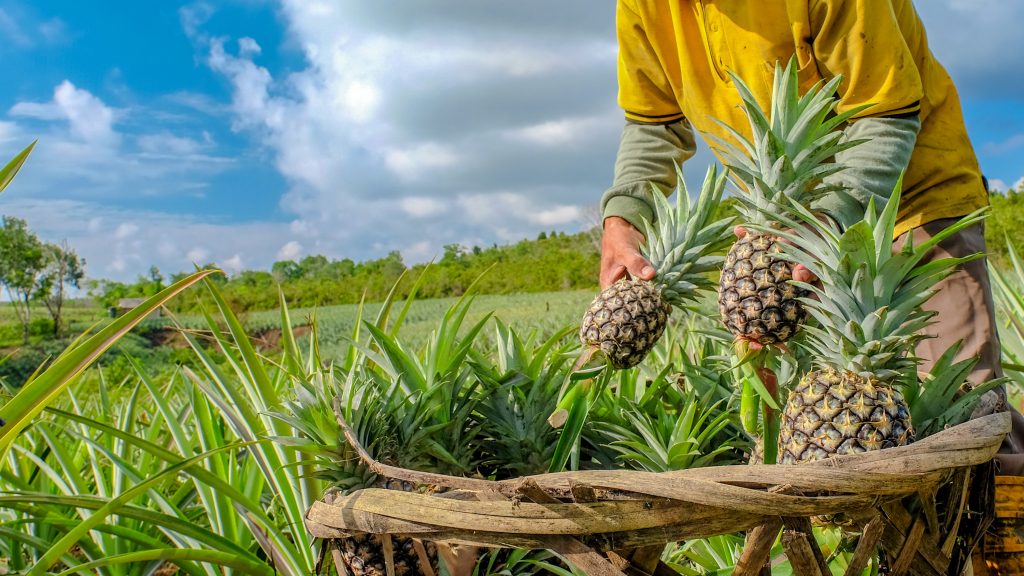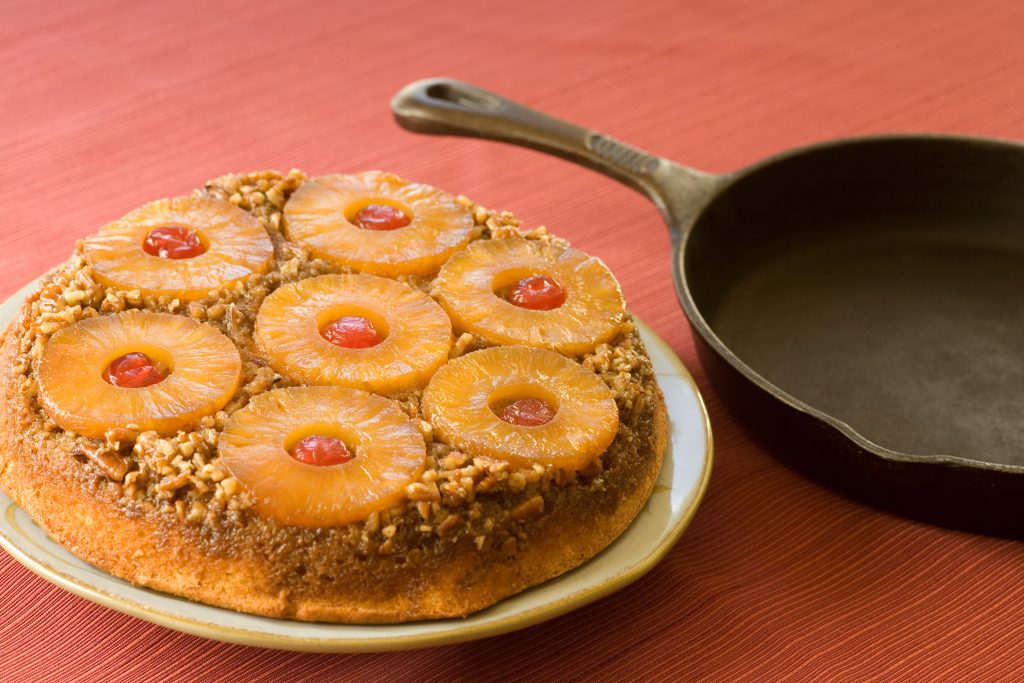Native to South America, this prickly fruit is a staple in kitchen classics from piña coladas to pineapple upside-down cakes. Their distinctive sweet and tropical flavor has made them a staple in kitchens around the world.
Table of Contents
What is a Pineapple?
The pineapple (Ananas comosus) is indigenous to South America and thrives in lush, tropical climates. In the wild, pineapples grow on a small shrub that can grow up to 11 feet tall. And one pineapple plant can grow up to 200 flowers on a single bush!
Pineapple’s flavors are uniquely tropical and toe the line between sweet and tart. Some pineapples are sweeter than others, and sometimes the base of a pineapple is sweeter than the top. Its bright and vibrant flavors make it excellent in sweet treats, and it’s full of beneficial vitamins and nutrients that are good for you!
The History of Pineapples
Today, pineapple manufacturing spans the entire globe, but the pineapple bush will always call South America home. It thrives in lush tropical climates in South Africa, Hawaii, Costa Rica, the Caribbean, and Brazil.
When Christopher Columbus arrived in Guadeloupe in 1493, he wrote about a lovely tropical fruit with a sweet and tart flavor: the humble pineapple. The fame of the humble pineapple spread like wildfire across the globe ever since.
Today, Hawaii is one of the leading harvesters of pineapple, making up ten percent of the worldwide production.

What Does a Pineapple Taste Like?
Raw pineapple has a wonderfully sweet and tart flavor with distinctive tropical acidic notes. Most of the sugars develop in the base of the pineapple, so it will taste sweeter and less acidic when eating pineapple from the base.
While it tastes terrific and tart when raw, this edible fruit is also a great cooking ingredient. When cooked, acidity and tartness fade into a sweet, tropical flavor in cakes, cookies, and pies.
How to Tell When Pineapple is Ripe
That spiky rind may make it difficult to tell when a pineapple is perfectly ripe, but there are a few tricks to ensure that you pick a pineapple at the grocery store at the peak of ripeness.
| Color | A perfectly ripe pineapple has a shell that is medium or light yellow. If there’s a little bit of green on the outside, that’s ok as long as the base is yellow. |
| Firmness | Be mindful of the spikes, and give it a firm squeeze. If the skin is slightly soft (like an avocado), it’s ripe. It needs a little more time to ripen if it’s rock-hard. |
| Smell | When smelling a pineapple, always sniff from the bottom. If it smells fragrant and floral, it’s ripe. If there is no smell, it’s underripe; if it smells of vinegar, it’s overripe. |
| Bruising | If there is slight bruising on the outside of the pineapple (that likely happened in the shipping process, that’s perfectly fine as long as it passed the other tests. |
| Spike Test | Another easy way to check for freshness is to remove one of the fronds (or spikes). If it comes away easily, it’s ripe. |
It’s important to note that once pineapples are picked, they won’t continue to sweeten or ripen off the bush. So picking up a pineapple at the peak of freshness is vital.
Cooking with Pineapples
Preparing a fresh pineapple may seem intimidating, but following these steps is super easy, and they’ll be ready for some tasty pineapple recipes.
- Remove the top and bottom. Using a serrated knife, cut the top and bottom off the whole pineapple and stand it upright on your cutting surface.
- Cut away the prickly skin. Take your serrated knife, and cut into the skin of the pineapple about a quarter of an inch into the flesh. Removing the pineapple eyes is essential because they can irritate your throat.
- Get rid of the core (optional). The core is edible, but some find it too tough. To remove the pineapple core, slice it into chunks, and use a biscuit cutter to remove the tough core carefully.

Here are some classic pineapple recipes that will surely be a hit!
Pineapple Upside-Down Cake: This classic cake is a tropical classic. It pairs the sweet, tropical flavors from pineapple with a moist vanilla cake and topped with sweet cherries. It’s so bright and lovely and looks so impressive!
Piña Colada: The Piña Colada is the perfect summertime cocktail; it tastes fresh, bright, and tropical. This recipe is super simple; you can use fresh or canned pineapples for those stunning flavors.
Sticky Pineapple Chicken: Sweet and tart pineapples aren’t just for desserts! This savory and moist pineapple chicken takes your dinner to new heights. It’s salty and sweet, and pineapple’s bright acidity is an excellent all-natural meat tenderizer.
How to Store Pineapples
Whole pineapples will stay fresh for up to three days when stored at room temperature. They will remain fresh for up to six days when stored in the refrigerator. Once it’s chopped into pineapple chunks, place them in an airtight container to remain fresh in the fridge for a few days.
To keep your pineapple fresher longer, it’s also a great candidate for freezing. Cut it into prepared chunks, and place them in a freezer bag. Frozen pineapple stays fresh in the freezer for 12 months.
Nutritional Benefits of Pineapples
Pineapples are quite the nutritional powerhouse. The health benefits of pineapples include a healthy dose of Vitamin A, potassium, manganese, calcium, antioxidants, bromelain, and Vitamin C.
The pineapple fruit is also a great snack if you’re watching your weight. One cup of pineapple has only 82 calories and 22 grams of carbohydrates.
Vitamin C-rich foods help naturally boost the immune system, lower cholesterol, and help your skin look healthy and bright. The higher levels of antioxidants reduce the risks of certain diseases such as heart disease and cancer. And the bonus of Vitamin A promotes good heart and lung health.
Where to Purchase Pineapples
The good news is that you can pick up pineapples anywhere, even at your local grocery store! They’re often sold whole, but some stores also carry pre-cut pineapple chunks or even canned pineapple.
The best time to pick up a pineapple at your local grocery store is in its peak season, from March to July.

